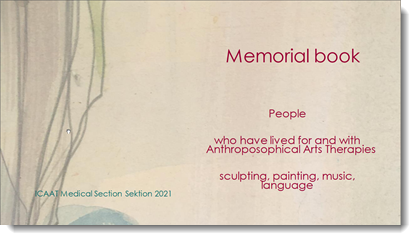History
Marianne Altmaier was the first coordinator for Anthroposophical Art Therapies (hereafter referred to as AAT). She was appointed in 1995 by Dr Michaela Glöckler, MD, the leader of the Medical Section. Marianne established the basic structures and introduced the following steps over a period of six years:
- Journeys in Germany and to GB, F, CH,I, FI, Brazil as a way of getting to know the art therapists and training schools through conversation, teaching and the comparison of curricula and examinations.
- The introduction of anthroposophical aspects into therapy (such as the fourfold way of looking at the human being and at pictures and the seven stages of the therapeutic process)
- Establishing common training and recognition criteria in the various countries.
- Efforts to unite the different schools.
- Editing of all books on AAT published in 2000 by Urachhaus.
- Moderation and co-organization of conferences for art therapists and heads of schools with lectures and group work.
- Lectures and publications.
When Marianne Altmaier resigned due to illness, Dagmar Brauer was appointed by the Medical Section as her successor. From 2001 to 2008 Dagmar focused mainly on:
- The coordination of the European Academy: opening the EA to other member schools; admissions; visiting school for evaluation.
- Maintaining communication with all training and professional development initiatives
- Maintaining communication with all anthroposophical professional associations
- Setting up a coordination faculty (network) with contacts for important specialist fields and subject areas.
- Representation within IKAM: co-organization of the Annual Conference, contributions for the Medical Section Newsletter, cooperation with other IKAM coordinators
- Publication of a newsletter
- Developing particular (disease-related) themes for the International AAT Conferences.
- Poster exhibition of all AAT training schools at the Goetheanum (presenting training and professional development initiatives)
- Maintaining a requirement list and the publication of annual activity reports
Dagmar Brauer was then succeeded by Kirstin Kaiser who was also appointed by Dr Michaela Glöckler and confirmed by the representatives of DAKART (the international umbrella group for AATs) and by the heads of the EA schools. The organigram (What We Do) or the annual Activity Reports reflect the current ICAAT structures and activities.
Under the leadership of Kirstin Kaiser, ICAAT was further expanded, and
- Co-coordinators for the areas of painting/plasticising and music/singing as well as for public relations were appointed,
- From DAKART and in collaboration with the eurythmy therapy associations ifaaet (international federation of anthroposophic arts- and eurythmy therapies) was founded and membership in ANME, CAM and AnthroMed was obtained.
- Research work in all fields of art therapy was brought together and new impulses were actively encouraged and
- A university work for the art therapists has been established, with meetings, writings and working groups during conferences.
- Specialist colleges were set up for the "care areas" created in 2017.
- Initiating and conducting 8 meetings of clinical therapists. Interprofessional networking at the clinics.
- Development and implementation of Teach the Teacher
- Development and implementation of auditor training for the accreditation of training courses
- Professionalization of the ICAAT Newsletter
- Development of AnthroMed in relation to the AKT up to the admission of the first associations
- Creation of all documents for the WHO process
- Initiation of the process of reissuing the four AKT books
- Establishment of an annual perspective conference in atS
All already existing tasks such as the representation in IKAM, the cultivation of contacts and the exchange etc. were of course continued.
In 2020 Kirstin Kaiser handed over the overall coordination to Laura Piffaretti. She was requested and commissioned by the coordinators and section leaders Matthias Girke and Georg Soldner for this work and confirmed by the IKAM College and the colleagues in ICAAT.
The current work processes and structures are shown in the organization chart under the menu item About Us

![[Translate to English:] ICAAT Startseite [Translate to English:] ICAAT Startseite](/fileadmin/_processed_/8/2/csm_buntes_Band_6_4efe3ae1d8.jpg)
